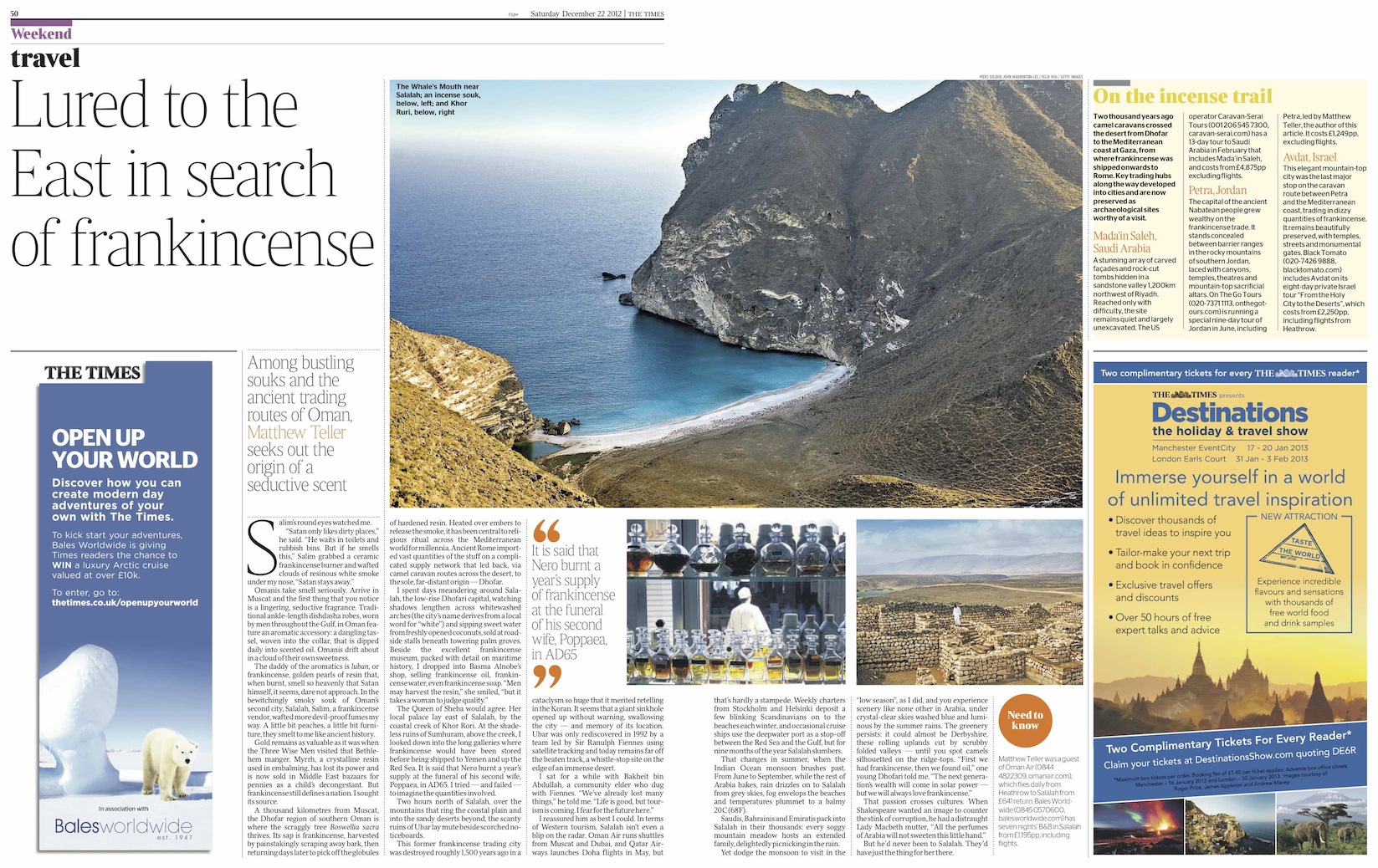Had a wonderful return visit to Dhofar in southern Oman a couple of months ago, on assignment for the Times, who wanted a frankincense story for their pre-Christmas travel pages. I happily obliged. Here’s the link – but it’s behind a paywall, so in case you’re not a Times subscriber I’ve pasted the text in (the unedited version, before anyone wielded a blue pencil), and also got hold of a PDF. Click to enlarge.
“Satan only likes dirty places.”
Salim’s round eyes watched me, making sure I understood.
“He waits in toilets and rubbish bins. But if he smells this –” Salim grabbed a ceramic frankincense burner off the counter and wafted clouds of resinous white smoke under my nose – “Satan stays away.”
Omanis take smell seriously. Arrive in Muscat and the first thing you notice is a lingering, seductive fragrance. Traditional ankle-length dishdasha robes, worn by men throughout the Gulf, in Oman feature a unique aromatic accessory: a dangling tassel, woven into the collar, that is dipped daily into scented oil. Omanis drift about in a cloud of their own sweetness.
But these are not the blended whiffs of commercial perfumiers. Souks and malls overflow with natural products that smell lovely. Visitors invariably latch onto culinary spices, but for locals the aromatics matter far more. Splinters of oud, a resinous wood imported from Cambodia, sell at wildly inflated prices for burning in the home. Bukhoor, woodchips soaked in aromatic oils, are equally popular.
The daddy of them all is lubban, or frankincense, golden pearls of resin that, when burned, smell so heavenly Satan himself, it seems, dare not approach. In the bewitchingly smoky souk of Oman’s second city, Salalah, frankincense vendor Salim wafted more devilproof fumes my way. A little bit peaches, a little bit furniture, it smelled to me like ancient history.
A thousand kilometres from Muscat, southern Oman’s Dhofar region is where the scraggly tree Boswellia sacra thrives. Its sap is what we know as frankincense, harvested by painstakingly scraping away bark, then returning days later to pick off the globules of hardened resin. Heated over embers to release the smoke, it has been central to religious ritual across the Mediterranean world for millennia. Ancient Rome imported vast quantities of the stuff on a complicated supply network that led back, via camel caravan routes across the desert, to the sole, far-distant source – Dhofar.
I spent days meandering around the low-rise Dhofari capital Salalah, watching shadows lengthen across whitewashed arches (the city’s name derives from a local word for “white”) and sipping sweet water from freshly opened coconuts, sold at roadside stalls beneath towering palm groves. Beside the excellent frankincense museum, packed with detail on maritime history, I dropped into Basma Alnobe’s shop, selling frankincense oil, frankincense water, even frankincense soap. Men may harvest the resin, she smiled, “but it takes a woman to judge quality.”
The Queen of Sheba would agree. Her local palace lay just east of Salalah, by the coastal creek of Khor Rori. At the shadeless ruins of Sumhuram, above the creek, I looked down into the long galleries where frankincense would have been stored before being shipped to Yemen and up the Red Sea. It is said that Nero burned an entire year’s supply at the funeral of his second wife, Poppaea, in 65 AD. I tried – and failed – to imagine the quantities involved.
Two hours north of Salalah, over the mountains that ring the coastal plain and into the sandy deserts beyond, the scanty ruins of Ubar lay mute beside scorched noticeboards. This former frankincense trading city was destroyed roughly 1500 years ago in a cataclysm so huge it merited retelling in the Quran. It seems a giant sinkhole opened up without warning, swallowing the city – and memory of its location. Ubar was only rediscovered in 1992 using satellite tracking by a team led by Sir Ranulph Fiennes, and today remains far off the beaten track, a whistle-stop site on the edge of an immense desert.
I sat for a while with community elder Bakheit bin Abdullah, who dug with Fiennes. “We’ve already lost many things,” he told me. “Life is good, but tourism is coming. I fear for the future here.”
I reassured him as best I could. In terms of Western tourism, Salalah isn’t even a blip on the radar. Oman Air runs shuttles from Muscat and Dubai, and Qatar Airways launches Doha flights next May, but that’s hardly a stampede. Weekly charters from Stockholm and Helsinki deposit a few blinking Scandinavians onto the beaches each winter, and occasional cruise ships use the deepwater port as a stop-off between the Red Sea and the Gulf, but for nine months of the year Salalah slumbers.
That changes every summer, when the Indian Ocean monsoon brushes past. From June to September, while the rest of Arabia bakes, rain drizzles onto Salalah from grey skies, fog envelops the beaches and temperatures plummet to a balmy 20C. Saudis, Bahrainis and Emiratis pack into Salalah in their thousands: every soggy mountain meadow hosts an extended family, delightedly picnicking in the rain. The desert they have at home. Wet green grass makes a holiday.
Yet dodge the monsoon to visit in quiet October, as I did, and you experience scenery like no other in Arabia, under crystal-clear skies washed blue and luminous by the summer rains. The greenery persists: it could almost be Derbyshire, these rolling uplands cut by scrubby folded valleys – until you spot camels silhouetted on the ridge-tops.
“First we had frankincense, then we found oil,” one insightful young Dhofari told me. “The next generation’s wealth will come in solar power – but we will always love frankincense.”
That passion crosses cultures. When Shakespeare wanted an image to counter the stink of corruption, he had a distraught Lady Macbeth mutter, “All the perfumes of Arabia will not sweeten this little hand.”
But he’d never been to Salalah. They’d have just the thing for her there.
